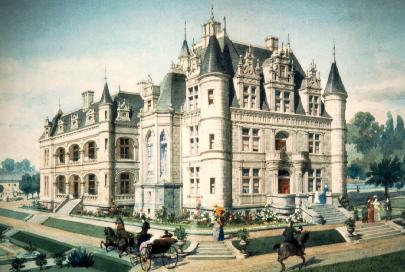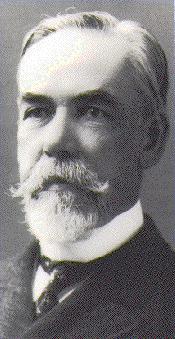
Kearney Mansion (1903)
7160 W. Kearney Boulevard
French
Renaissance
Rudolph Ulrich, landscape architect
Description
The Kearney Mansion is located seven miles west of downtown Fresno. It consists of two buildings, a main residence and an adjoining servants' quarters. The two buildings are designed in the French Renaissance style, simulated through the use of materials indigenous to the area and through the use of Victorian stock moldings, all built by workers employed by owner M. Theo. Kearney. Both buildings have a basic rectangular form with walls of two-foot-thick unstabilized adobe brick, covered with a thin coat of plaster for waterproofing. The basic adobe structures are capped by a sophisticated roof structure, strongly influenced by the Schwab residence in New York City, which itself was a copy of Chateau de Chenonceaux. The high roofs, dormer windows, ornate pinnacles at the intersection of the high roofs, the simple ridgemolding, and lofty chimneys create a picturesque skyline.
The interiors of both structures have typical Victorian details for trim, crown moldings, fireplaces and stair railings. In the main residence, wall finishes were imported wallpapers from France, designed to Mr. Kearney's suggestions of colorful, elaborate scenic representations.
 Kearney intended the existing structures as part of a
much larger complex known as "Chateau Fresno." He retained several architects,
including Thomas E. Collcutt, Willis Polk and
Maurice Hébert, to design the complex.
The present-day "mansion" was not intended to be Kearney's main residence, but
rather the caretaker's lodge. Kearney lived in it while awaiting completion of
his much grander chateau (on left), which was never actually built. At the time
of his death in 1906, only the residence and servants' quarters had been
completed.
Kearney intended the existing structures as part of a
much larger complex known as "Chateau Fresno." He retained several architects,
including Thomas E. Collcutt, Willis Polk and
Maurice Hébert, to design the complex.
The present-day "mansion" was not intended to be Kearney's main residence, but
rather the caretaker's lodge. Kearney lived in it while awaiting completion of
his much grander chateau (on left), which was never actually built. At the time
of his death in 1906, only the residence and servants' quarters had been
completed.
Today the mansion, operated by the Fresno City and County Historic Society as a museum, exhibits 50 percent of the original furnishings, including wallpapers and art nouveau light fixtures. Historic replicas of carpets and other wallpapers have been used where original fabric has been lost. The servants' quarters houses the museum store.
The Kearney Mansion is located in the 225-acre "Chateau Fresno Park" (now Kearney Park), begun by Kearney in 1892. Rudolph Ulrich, the noted American landscape architect from New York, laid out the design for this park and the boulevard leading to it. Over the next fourteen years, Kearney turned a flat, barren landscape into one of the most beautiful parks in the United States. At the turn of the century the park may have contained more species of trees, vines, shrubs and roses than any equal area in the United States. The San Francisco Chronicle called it the "most beautiful park on the West Coast." The eleven-mile boulevard leading from downtown Fresno to the park was lined with alternating eucalyptus and palms, interspersed with 18,000 white and pink oleanders.
Historical significance
 Martin
Theodore Kearney (1842-1906) was a substantial contributor to the agricultural
development of both Fresno County and the state of California. He began his
career in Fresno by managing the Central California Colony development for W.
S. Chapman and Bernhard Marks of San Francisco. Kearney devised a subdivision
system whereby fencing and irrigation for all the lots in the colony were
provided cooperatively. This enabled middle-class purchasers to start farming
without the tremendous financial outlay otherwise necessary. Kearney later
promoted several developments of his own, including the Easterby Colony east of
Fresno, and the Fruit Vale Estate to the west. He advertised Fresno County far
and wide, using various attractive promotional brochures that described Fresno
as a veritable Garden of Eden.
Martin
Theodore Kearney (1842-1906) was a substantial contributor to the agricultural
development of both Fresno County and the state of California. He began his
career in Fresno by managing the Central California Colony development for W.
S. Chapman and Bernhard Marks of San Francisco. Kearney devised a subdivision
system whereby fencing and irrigation for all the lots in the colony were
provided cooperatively. This enabled middle-class purchasers to start farming
without the tremendous financial outlay otherwise necessary. Kearney later
promoted several developments of his own, including the Easterby Colony east of
Fresno, and the Fruit Vale Estate to the west. He advertised Fresno County far
and wide, using various attractive promotional brochures that described Fresno
as a veritable Garden of Eden.
From 1898 to 1905 Kearney was associated with the California Raisin Growers Association. He worked to stabilize the raisin industry through a tightly-controlled association, elimination of middlemen and an improved product for market. Though it seemed at the time that Kearney's efforts had failed, the Sun Maid Raisin Company was later founded on many of Kearney's managerial principles.
As early as 1899 Kearney had decided to leave his estate to the Regents of the University of California in hopes that they would establish a college of agriculture there, with the proposed Chateau Fresno as the administration building and his park as the campus. At the time of Kearney's death, his estate consisted of $1.5 million and 5400 acres of farm land.
By 1949 the University had sold all the land except for the park. It was leased to Fresno County, and in 1962 the mansion was leased to the Fresno City and County Historical Society as a museum.
Adapted from the Fresno County Landmarks nomination, originally prepared by Rosellen Kershaw; the National Register of Historic Places nomination, originally prepared by William E. Briam; and information provided by the Fresno City and County Historical Society.
For further information on public tours of the Kearney Mansion, please call 559-441-0862.
Photograph of Kearney Mansion by Kingsley Roberts, Jr. ©Fresno City and County Historical Society. All rights reserved. Used by permission.